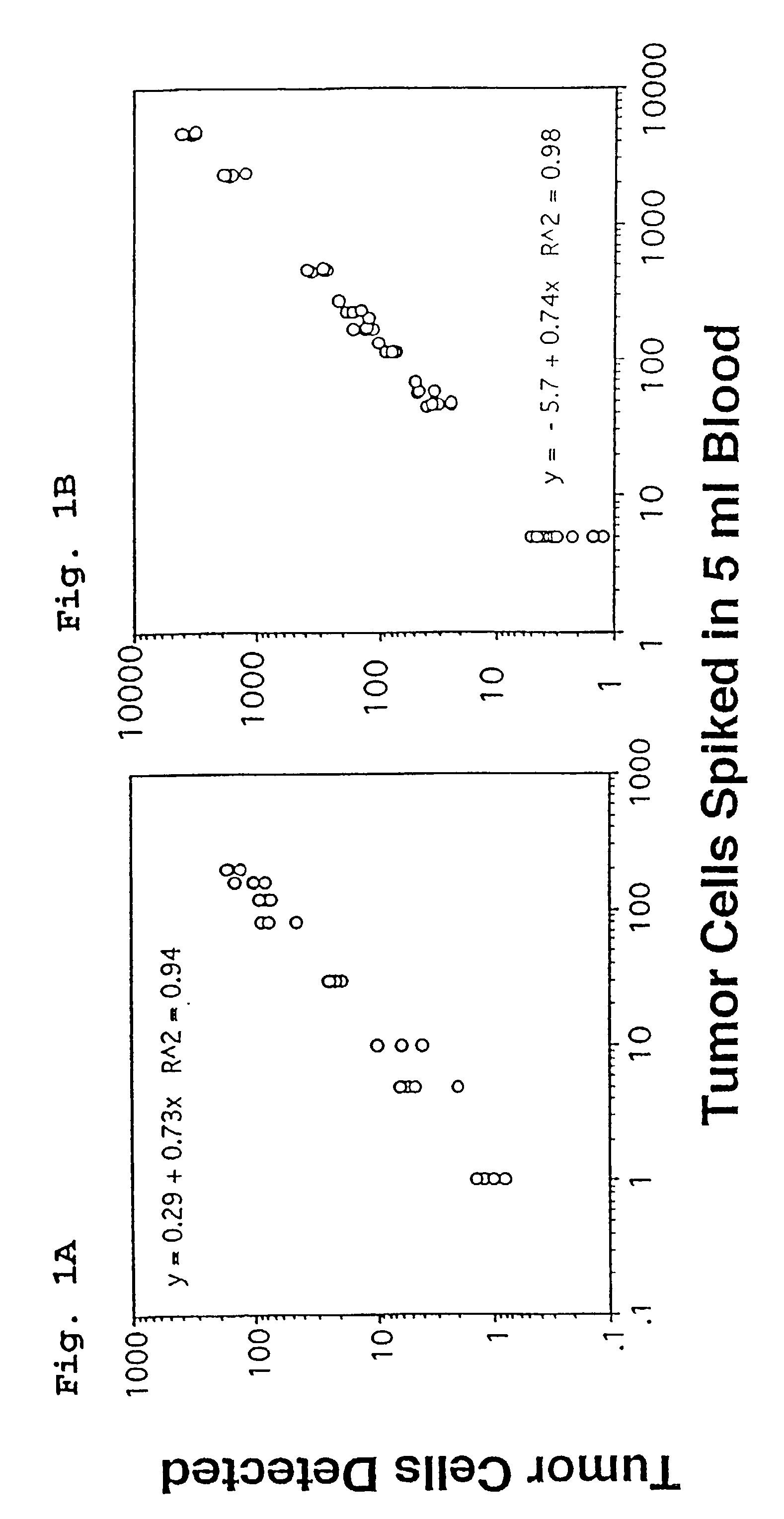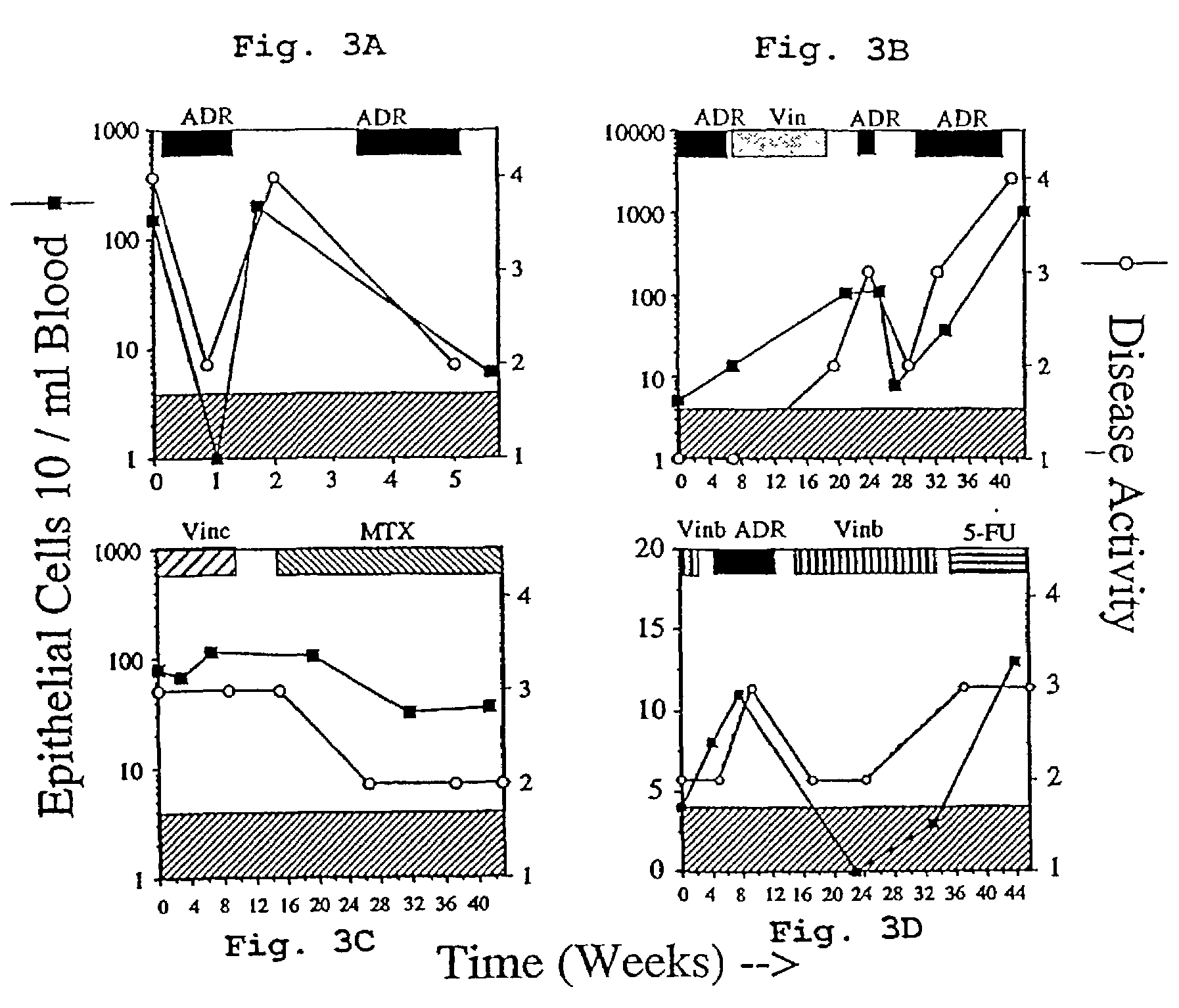Methods and reagents for the rapid and efficient isolation of circulating cancer cells
a technology reagents, which is applied in the field of methods and reagents for the rapid and efficient isolation of circulating cancer cells, can solve the problems of difficult detection and elimination of colonies, inability to treat all of them successfully, and efforts that have proved to be somewhat futil
- Summary
- Abstract
- Description
- Claims
- Application Information
AI Technical Summary
Benefits of technology
Problems solved by technology
Method used
Image
Examples
example 1
Formulation of Improved Magnetic Nanoparticles for the Efficient Isolation of Rare Cells from Whole Blood
[0071]Rare cells (e.g., tumor cells in patients with epithelial derived tumors, fetal cells in maternal blood or the like) can be present in frequencies below one rare cell per ml of blood. The number of blood smears required to detect such rare cells is prohibitively large. Assuming 10 rare cells in 10 ml of blood, which corresponds to 10 tumor cells in 5-10×107 white blood cells (leukocytes), cells can be transferred to a microscope slide by cytocentrifugation or by settling, stained with an antibody specific for the rare cells of interest and read manually or automatically. The maximum number of cells that can be transferred to one slide is about 500,000 cells which means 100-200 slides are required to process 10 ml of blood. The time required for analysis by this approach makes it impractical and economically unfeasible. Consequently, enrichment methods such as sample volume ...
example 2
Enumeration of Circulating Epithelial Cells in Patients Treated for Metastatic Breast Cancer
[0081]FIG. 1 shows the results obtained when tumor cells spiked into whole blood are isolated using the assay methods of the present invention. Panel A shows analysis by microscopy and panel B shows analysis results obtained using flow cytometry. FIG. 2 shows three examples of the flowcytometric analysis of 10 ml blood samples obtained from one patient with metastatic breast carcinoma at three time points, and includes the correlative display of the anti-leukocyte versus anti-epithelial cell antibodies of the flowcytometric analysis. In FIG. 2, Panel A, 14 events are detected and are present in the location typical for epithelial cells. In Panel B, 108 epithelial cells are detected and in Panel C 1036 epithelial cells are detected.
[0082]The number of events passing the threshold set on the nucleic acid dye in the analysis of the 10-ml blood sample varied between 5,000 and 50,000 events. These...
example 3
Enumeration of Circulating Epithelial Cells in Patients with No Evidence of Disease After Surgery for Carcinoma of the Breast with Curative Intent
[0100]Peripheral blood of 37 patients between 1 and 20 years after surgery was examined for the presence of epithelial cells by flowcytometry. Up to 7 peripheral blood samples were taken over a one-year period from these patients. In Table III, each of the patients is listed and sorted according to the TNM (tumor, node, and metastasis) stage at the time of surgery followed by the years after surgery. Table III also shows whether or not the patient received treatment (either chemotherapy or hormonal therapy) during the period studied. In 3 of 6 patients with evidence of distant metastasis in the past, but in complete remission at the time of study, epithelial cells were found in the blood at a higher frequency than that found in the control group. Circulating epithelial cells were also found in 9 of 31 patients with no evidence of distant m...
PUM
| Property | Measurement | Unit |
|---|---|---|
| Fraction | aaaaa | aaaaa |
| Fraction | aaaaa | aaaaa |
| Volume | aaaaa | aaaaa |
Abstract
Description
Claims
Application Information
 Login to View More
Login to View More - R&D
- Intellectual Property
- Life Sciences
- Materials
- Tech Scout
- Unparalleled Data Quality
- Higher Quality Content
- 60% Fewer Hallucinations
Browse by: Latest US Patents, China's latest patents, Technical Efficacy Thesaurus, Application Domain, Technology Topic, Popular Technical Reports.
© 2025 PatSnap. All rights reserved.Legal|Privacy policy|Modern Slavery Act Transparency Statement|Sitemap|About US| Contact US: help@patsnap.com



